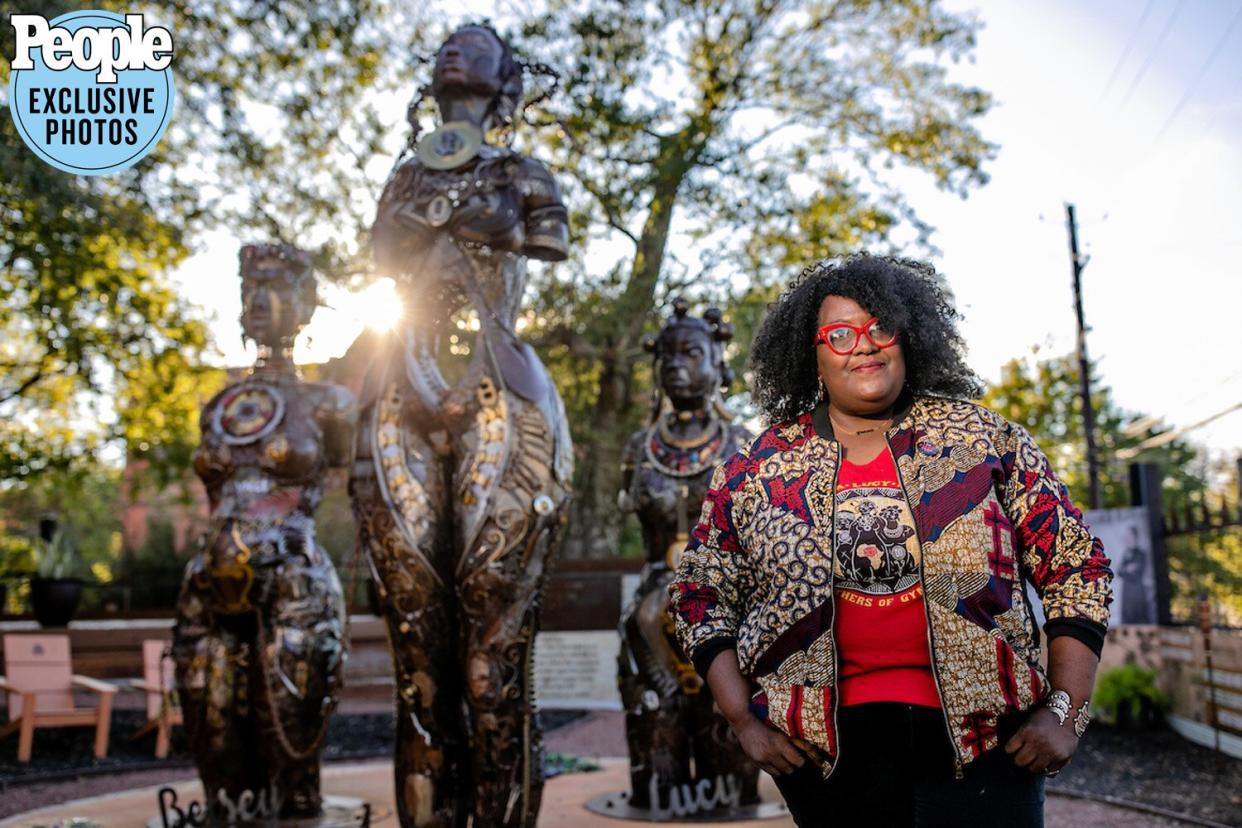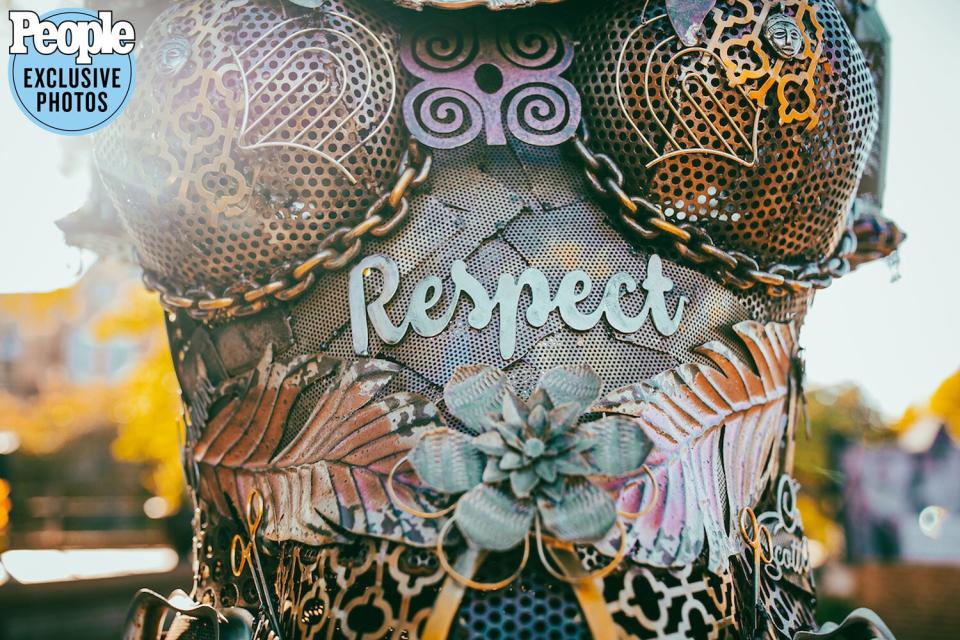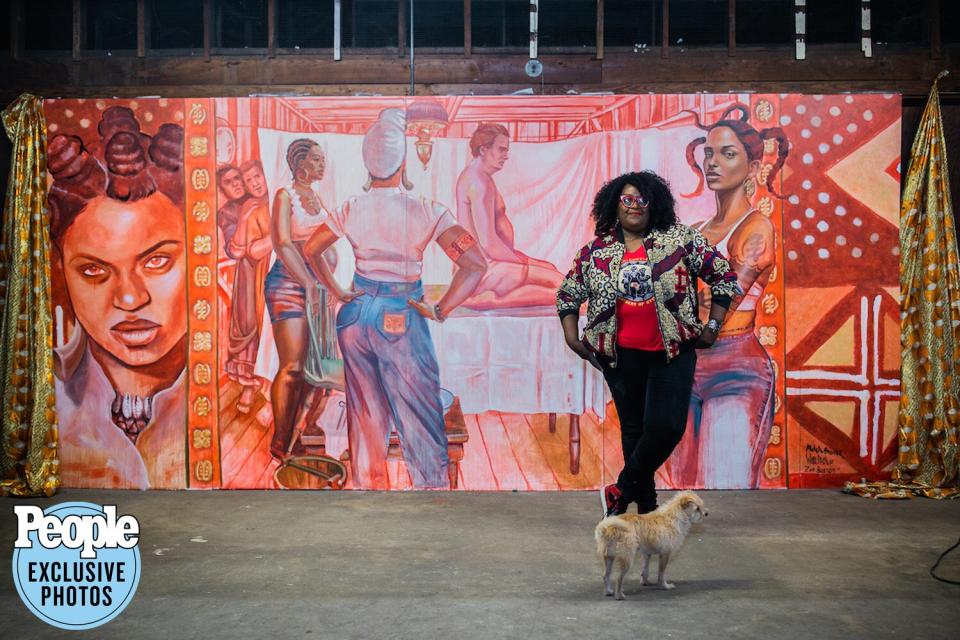Artist Michelle Browder Creates 'Mothers of Gynecology' Monument to Enslaved Women Who Endured Experiments

- Oops!Something went wrong.Please try again later.
Tamika Moore for People Magazine Artist Michelle Browder in October in front of her Mothers of Gynecology Monument in Montgomery, Ala.
More than 30 years ago, as an 18-year-old art student in Atlanta, Michelle Browder came across a work of art that haunted her — and moved her to uplift a group of enslaved women that history, and medicine, forgot.
Painted in about 1952 by commercial artist Robert Thom as part of a collection called 'Great Moments in Medicine," the picture that Browder encountered in her art school figure drawing class showed a young African-American woman kneeling on an exam table while three white men in suits stood nearby, studying her. Peeking from behind a sheet that divided the room were two other African-American women, both wide-eyed. "They were girls, just a year maybe younger than me at the time," recalls Browder, now 51, of the three women. "The look on their faces, I was troubled so bad."
The painting was meant as a tribute of sorts to the man pictured on the right, a 19th century doctor named Dr. J. Marion Sims, long known as the 'Father of Gynecology' for his contributions to the field, including the development of a medical tool known as the Sims vaginal speculum, still used today during some gynecological surgeries. At the time, however, the three women depicted in the artwork were largely lost to history.
Browder was determined to learn their stories.
The women, who she discovered were named Anarcha, Lucy and Betsey, were not just patients of Sims — they were three of about a dozen enslaved women the doctor had kept in a make-shift hospital in Montgomery, Ala., where they were used for his medical experimentation. All three suffered from vaginal fistula, a painful tear caused by traumatic childbirth, and because they were unable to bear more children as a result, they had lost their value to the plantation owners where they lived and were handed over to Sims.
In an attempt to develop a technique to repair the tear, Sims performed surgery on them repeatedly — without anesthesia, because he believed that Black people did not feel pain the same way white people did. (Even recent studies have shown that many medical students still carry the same sorts of biases.)
"It was a crime against humanity," Browder says. "Often these girls would have to hold each other down. Lucy had 12 surgeries and it nearly killed her — there are reports of her screaming in pain."
Soon after seeing that painting, Browder began imagining the lives of the three young women, and their suffering, and she started sketching them for her portfolio. In 2002, when she moved to Montgomery, where a statue of Sims still stands in front of the state capitol building (a likeness in New York City's Central Park was removed in 2018), she vowed to find a bigger, more public way to honor Anarcha, Lucy and Betsey, the "Mothers of Gynecology" as she's come to refer to them.
"When I'd see that statue of Sims, I was infuriated," says Browder, who grew up in nearby rural Verbena, Ala., as the daughter of the state's first Black prison chaplain. "How can this one person be elevated and amplified and heralded as the father of modern gynecology but there's no mention of these enslaved women, girls that were raped and trafficked? I said, 'I'm going to change that. I'm going to erect a monument.'"
On Mother's Day this year, Browder officially opened her Mothers of Gynecology Monument, three figures representing Anarcha, Lucy and Betsey. Located in a historically Black neighborhood in Montgomery, down the street from the city's National Memorial for Peace and Justice honoring victims of lynching and racial injustice, the sculptures are extraordinarily intricate feats of welding. (Browder worked on the design with San Francisco-based artist Dana Albany, whose work inspired the look of the sculpture and who taught Browder to weld.)

Tamika Moore for People Magazine
Betsey wears a tiara constructed of speculums. Discarded objects — spoons, bike chains, tea cups, doorknobs, jewelry — were donated by women around the country and welded into the figures. "Black women in this country are discarded. We're not listened to, we're treated in essence like trash a lot of times," says Browder of the significance of turning junk into art. "We find beauty in the broken." The names of women who celebrate Black strength and Black female bodies scroll across the figures — Lizzo and activist Angela Davis, Oprah Winfrey and Serena Williams. "I want people to sit with them," she says of the figures. "Sit with the fact that these women were tortured for the sake of healthcare and science and have largely been left out of the conversation."
The monument is just the first step in a much larger plan Browder, who also runs a youth outreach program and owns More Than Tours, has created for the Mothers and for Montgomery. She hopes her More Up Campus — a $5.5 million vision that's already received some funding from the Monument Lab and the Mellon Foundation — will one day include a museum and a travel center. And this week, she's announcing the latest phase of the project, bringing the story of Anarcha, Lucy and Betsey full circle.
Earlier this year, Browder bought a two-story building that sits on the very site where Sims performed his experiments on enslaved women, a 15-minute walk from where the Mothers stand. Her plan is to break ground on Mother's Day 2023 and construct the Mothers of Gynecology Health and Wellness Clinic — a space that will hold a museum honoring the Mothers, a training center for doulas and midwives focused on serving Black women (who are nearly three times more likely to die in childbirth or childbirth-related complications than white women) and a clinic that will provide women's healthcare to the surrounding community.
RELATED: Black Newborns Are More Likely to Survive Under the Care of Black Doctors, Study Finds
"It's almost reparations," Browder says of converting the space, for which she is launching a capital campaign for donations. "It's repairing that which has been broken in our healthcare system and trying to not only repair but to teach." It is, she says, a "Sankofa" — a Ghanaian symbol that she explains as meaning: "we look back in order to gain that which is lost so that we can move forward."
At the heart of the clinic, Browder plans to hang her newest artistic creation, a mural she's just unveiled that changes the power dynamic of the painting that so disturbed her years ago. Created in collaboration with two fellow Oakland-based artists, Rachel Wolfe-Goldsmith and Zoe Boston, and partially funded by the Monument Lab, the new painting shows Sims on the exam table, naked. Surrounding him are strong, modern versions of Anarcha, Lucy and Betsey. "We needed to flip the script, put him in our shoes and see how it feels," Browder says.

Tamika Moore for People Magazine Browder in October, unveiling her new mural.
Owning the space where Sims once worked, "was poetic justice," she says. "It was like a calling from the ancestors — they wanted peace." And she hopes the artwork hanging there, and the statues a few blocks away, can begin to change mindsets. "I think about the women and the girls that these women will touch," she says. "It's not just a piece of art, it's a way to teach and integrate this conversation of maternal health and respect and dignity for humankind."

